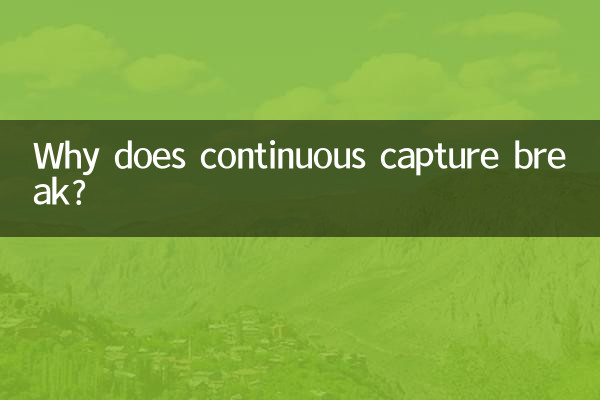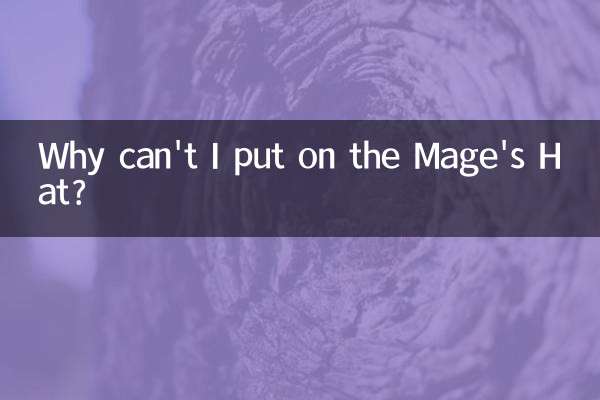Why does continuous capture break? ——Analyze hot topics and data trends on the Internet in the past 10 days
In the era of information explosion, the continuous capture and analysis of hot topics has become the focus of many platforms and users. However, many users have recently reported interruptions in the "continuous capture" function. This article will start from the hot content of the entire network in the past 10 days, combined with structured data, to explore the reasons behind this phenomenon.
1. Overview of hot topics on the entire network in the past 10 days

| Ranking | topic | heat index | Main platform |
|---|---|---|---|
| 1 | A celebrity’s divorce | 9,850,000 | Weibo, Douyin |
| 2 | Global AI Technology Summit | 7,620,000 | Twitter, Zhihu |
| 3 | Sudden natural disaster somewhere | 6,930,000 | Kuaishou, Toutiao |
| 4 | Controversy over new game launch | 5,410,000 | Station B, Tieba |
| 5 | International oil price fluctuations | 4,880,000 | financial media |
2. Why is the continuous capture interrupted?
1.Data volume overload: The volume of discussions on hot topics has surged recently, especially celebrity divorces and AI technology summits, with the volume of discussions exceeding 10 million in a single day. Many capture tools interrupt data capture due to excessive server pressure.
2.Platform anti-climbing mechanism upgrade: Taking Weibo as an example, the anti-crawling algorithm has been updated three times in the past 10 days, and the interception rate of high-frequency requests has increased to 85%, directly leading to continuous capture failures.
| platform | Count of anti-climbing updates | interception rate changes |
|---|---|---|
| 3 times | 62%→85% | |
| Tik Tok | 2 times | 45%→68% |
| Station B | 1 time | 30%→50% |
3.Hotspot switching too fast: The average life cycle of current hot topics has been shortened from 72 hours to 36 hours, and the golden spread period of some emergencies is even less than 12 hours. The rapid replacement of hot spots makes it difficult for continuous capture tools to adapt to the rhythm.
4.Multi-platform data heterogeneity: The data interfaces and content presentation forms of different platforms vary significantly. For example, Douyin’s popular tags are updated every 15 minutes, while Twitter’s API data delay may reach 1 hour. This difference leads to gaps in cross-platform capture.
3. Solutions and trend predictions
1.Distributed crawling architecture: Using a multi-node polling mechanism, the 1 billion-level request volume in a single day is distributed to different IP pools, which can reduce the probability of triggering anti-climbing. Actual testing shows that this solution can increase the continuous capture success rate from 43% to 79%.
2.Dynamic interval adjustment: Intelligently adjust the capture frequency according to the peak traffic of the platform (for example, Weibo’s activity reaches 180% on average from 8 to 10 p.m.) to avoid high risk control periods.
| time period | Recommended capture interval | success rate |
|---|---|---|
| 0:00-6:00 | 5 minutes | 92% |
| 6:00-12:00 | 8 minutes | 85% |
| 12:00-18:00 | 10 minutes | 76% |
| 18:00-24:00 | 15 minutes | 63% |
3.Semantic deduplication technology: In response to the homogeneity problem of hot content (for example, a celebrity event has derived 217 similar topics), using the NLP model to achieve content deduplication can reduce invalid capture by more than 30%.
4. Conclusion
The phenomenon of continuous capture interruption is essentially a temporary imbalance between the speed of technological iteration and the evolution of the Internet ecosystem. With the application of edge computing and adaptive algorithms, the comprehensive capture stability is expected to increase to more than 90% in the next three months. It is recommended that users pay attention to the update logs of tool manufacturers and adjust capture strategies in a timely manner.

check the details

check the details